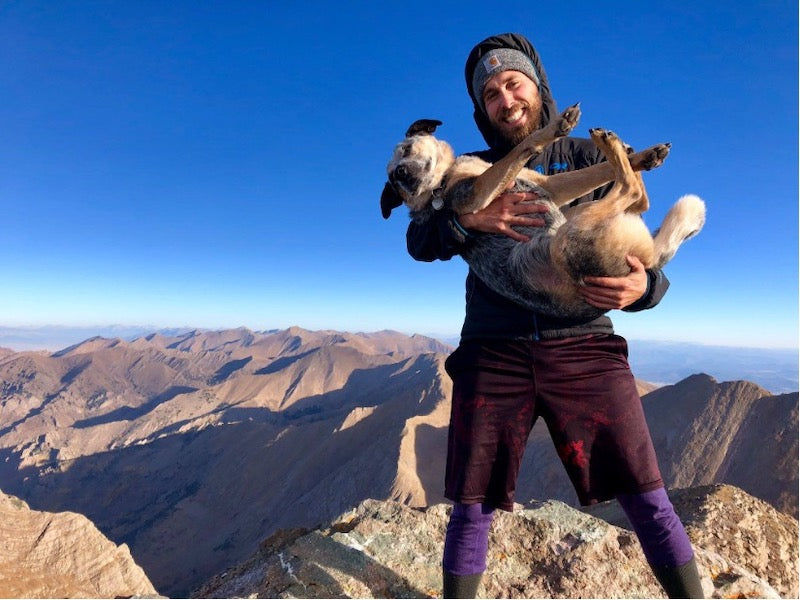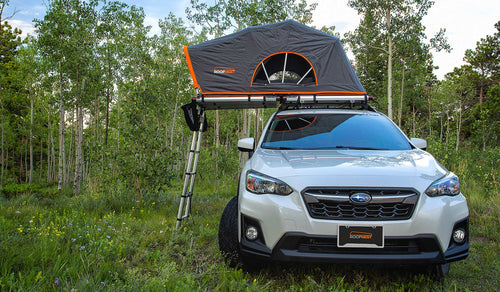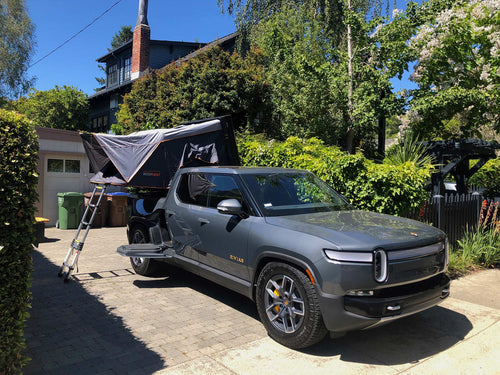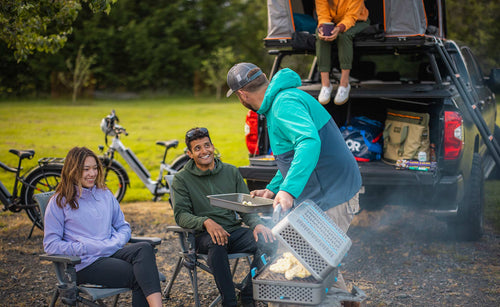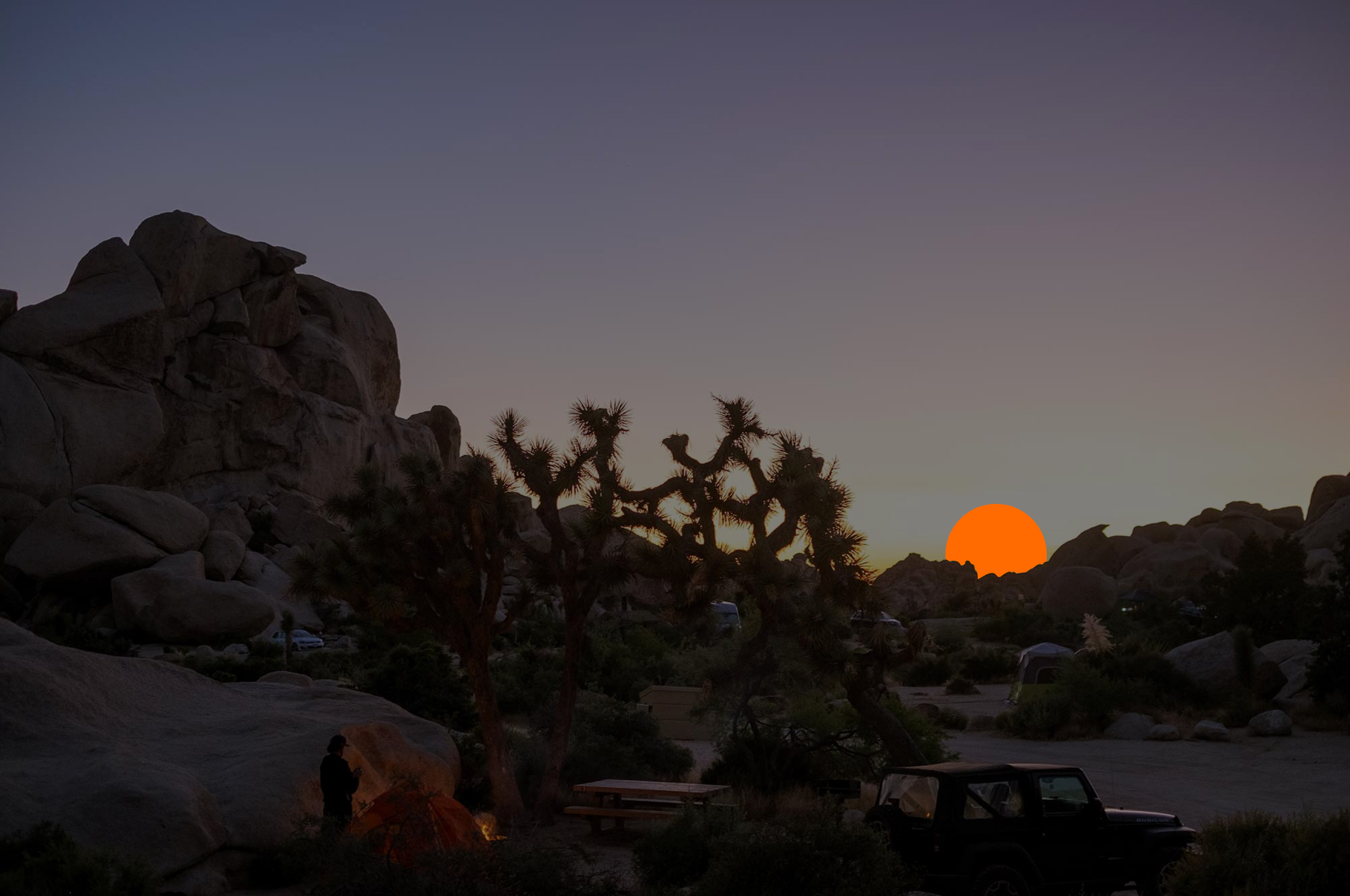Author: Ian Krammer
What’s more “Colorado” than hiking in the mountains? Climbing a fourteener!
Fourteeners offer unrivaled views, a deep sense of personal accomplishment, and a guaranteed giant adventure. They’re both the highest points in Colorado and in the US.
Colorado is home to 58 total (53 “ranked” plus 5 “unranked”) peaks over 14,000 feet. It’s a huge achievement to summit any of these scenic behemoths, but doing so takes a lot of research and preparation — for visitors and locals alike.
My name is Ian Krammer. I grew up in Colorado Springs, but my 14er journey started in the summer of 2015, on Long’s Peak.
The experience was so jaw-dropping, unique, and rewarding, I became obsessed overnight. For the remainder of that summer, I hiked a different fourteener every week.
The following summer, I climbed two 14ers a week. By 2018, I had climbed all 58, including several repeats.
My hiking partner on most of the fourteeners was
my blue heeler, Blodgett, who completed the 50 dog-friendly summits at my side.
(Blodgett has also
made a name for himself in the news for his skills in Barkour, aka parkour for dogs. You can follow his adventures on Instagram at
@blodgettthegreat). You can read more press on him at the very bottom of this blog.
I’m now committed to climbing all of Colorado’s 764 ranked and unranked thirteeners (13,000’+ mountains), with 380+ summits so far. Blodgett has 102 under his belt!
Read more about my mission to climb every 13er in Colorado >
Since I was a kid growing up in Colorado, I’ve seen the population in our state explode. For better or worse, Colorado’s 14ers have become increasingly popular, too. Crowds at altitude are the new norm.
More people in the backcountry means an inevitable increase of mistakes, injuries, rescues, or worse. Colorado Search and Rescue organizations are busier than ever, with a majority of missions involving rescues on a fourteener.
Fortunately, this doesn’t need to be the case, especiall
y for you and your hiking group. With intentional training, the right information, and basic preparation, anyone can thrive at altitude.
Here are my top tips for safely and successfully summiting a Colorado fourteener this summer — whether you’re a seasoned local or a first-timer.
Research Your Route
I used to hate researching fourteener hikes before heading out.
I’d think:
It’s a hike, we just follow the trail.
More experienced climbers will know where we’re going.
Doesn’t knowing everything about the route ruin the surprise?
The answer is a hard
no. There should be no surprises about your gear, the weather, or your route. Hiking the tallest peaks in the US can be a dangerous undertaking — that’s part of what makes it an adventure!
The more you know about where you’re going, how to get there, and what the trail is like, the more safety and comfort you’ll enjoy on the hike itself.
Plus, you don’t have to trust that someone else in your group has looked up the right information (they probably haven’t).
Learn to love the research! These days, it’s exciting to find out where I’m going and to explore and read the routes in advance.
How Colorado 14ers are Ranked
All 58 Colorado 14ers are ranked by difficulty, from Class 1 (easiest) to Class 5 (difficult).
While there are no easy 14er hikes, this system is helpful for choosing a route that works best for your skill and comfort level.
Factors that make a route more difficult include:
- The amount of exposure to the elements
- Severe drops or open ledges
- The amount of route-finding or lack of trail
- If any climbing is required
- Overall distance
Class 1 Routes
With Class 1 routes, the trail is typically very well established and maintained — like Pike’s Peak, Quandary Peak, and Grays Peak.
Class 2 Routes
Class 2 is the biggest category for most fourteeners, and can involve scree, talus, snow climbs, exposure, and is more challenging across the board. My favorites are Mount of the Holy Cross, Huron Peak, and Missouri Mountain.
Class 3 Routes
Class 3 14ers require 3 points of contact on most parts of the route, with scrambling and un-roped climbing over extreme landscapes. My favorite Class 3 14er is Longs Peak.
Class 4 Routes
Class 4 requires climbing and demands four points of contact and slow, careful movement. Rope may be helpful on some of these routes. Think of Capitol Peak here, with its sharp, short section the “Knife’s Edge,” with hundreds of feet of drop on either side.
Class 5 Routes
Class 5 is technical climbing with gear. No standard Colorado 14er routes are Class 5.
Best Resources for Researching Your 14er Route
In mountain climbing, information truly is power. Why not choose to be powerful?
From websites to apps to books to paper maps, here are some of my favorite resources for researching your 14er route (and what makes them so great).
14ers.com, run by Colorado mountaineer and Breckenridge local Bill Middlebrook, brings the peaks to you!
14ers.com is free and offers unfettered access to its member forums. Mountain climbing is nothing without its people, and the forums are a great place to ask questions, find climbing partners, and revel in memories when you get home.
This is a very active community — both physically and online — so being a “member” is a great way to plug in and make friends. If you’re doing more than a few fourteeners, consider signing up for an account.
On 14ers.com, every fourteener has its own detailed page to help you decide which to climb.
From downloadable GPX files to topo maps, weather reports to peak conditions, trailhead pins to parking areas, these mountain profiles are easy to navigate and full of important information.
Route Description
The “Route Description” section on 14ers.com is essential. With detailed pictures and thorough, concise writing, the “official” route description of each 14er breaks your hike into 10-30 parts.
This helps prepare you for what is coming by illustrating your entire hike. I take screenshots on my phone of every picture and description, download the GPX route to my GPS app, and then pin the trailhead on my maps app. I study them carefully afterward.
Having this route information accessible before and during the hike lowers any chance of getting off-track!
Trip Reports
Next, look at the “Trip Reports” section. Tens of thousands of people have hiked these 14er routes before you, and some have written detailed — and often beautiful — reports of their climbs.
I love Trip Reports for the expert advice. Other hikers warn about mistakes to avoid, things to look for, and where the best flowers are.
This is also a great way to get specific, current information like wildlife reports and trail conditions.
Lost and Found
There is a “Lost and Found” section for that hiking pole you ditched in the woods and forgot about or that glove that fell out of your pack.
14ers.com Facebook Group
You can also find your people on the other half of the “dot com.” 14ers.com Facebook members post pictures, tell stories, ask questions, look for advice, and post updates about routes.
The Facebook group is a faster, easier way to get a question answered. In less socially distant times, the group has a quarterly meetup and coordinates hikes and is a great place to organize with other groups or find last-minute hiking partners.
You can join the Facebook group here >
I use SummitPost to supplement 14ers.com. The Colorado 14ers sections are all-encompassing and have Trip Reports and active community forums.
I use SummitPost most often for its detailed trailhead and parking descriptions. I screenshot those in advance and save them on my phone for the trip.
Widely considered the preeminent guidebook for Colorado Fourteeners, Roach’s paperback is comprehensive and meticulous.
If you’re climbing more than a couple of 14ers, this is the one obligatory purchase I’d recommend. He lists interesting alternative routes to most fourteener summits, so as you progress, the book only becomes more relevant.
YouTube Videos
There are videos for all fourteeners now, and these can be helpful to understand the difficult sections, or “cruxes.”
While you can never be too careful, be warned of exaggeration. For example, many videos are taken with the “fisheye lens” effect from GoPro’s, selfie sticks, and filters. These can severely distort images by making cliffs look vertical, drops look three times as big, and frames the overall experience as more “extreme.”
Watch with a suspicious and rational eye on YouTube. Some of these are tough mountains, but this isn’t the Himalayas!
Researching the Weather
The best summer hiking conditions for Colorado 14ers are between late June and early September.
In summer, most hikers start between 3:30 and 6:30 AM. The rule of thumb is to be off the summit no later than noon because Colorado’s summer thunderstorms are real and terrifying.
The summer weather pattern leans towards unpredictable afternoons full of thunderstorm activity. The higher you are in altitude, the more extreme and fast-moving the weather.
I recommend finding a forecaster you trust and checking in every day leading up to your hike. Weather at altitude is as important as the route!
Colorado weather is very difficult to predict. I’ve been caught in a lightning storm, graupel, torrential rain, freak snow, and multiple days of 60+ mph winds when the weather said it would be calm and clear.
While you gain experience in reading the weather, use these resources!
- The official NOAA site.
- Look up nearby towns, passes, or the actual 14er itself for the forecast.
- Seth Linden is a Westminster-based meteorologist with an impressive knowledge of how weather moves across Colorado.
- Seth puts out a mountain forecast for the state several times a week.
- Because of the targeted forecasting and impressive accuracy, this page is an excellent resource for your 14er planning.
- Type in the name of your fourteener, get a hyper-specific forecast for the next week.
- It gives readouts for 9,000, 12,000, and 14,000 feet.
- Also includes details like wind speed and direction, the high and low, and precipitation.
Bring a Map
Finally, don’t rely solely on your phone for important route information. If it dies, falls out of your pack, or fails, you’ll be happy for backup.
Apps are fine, but old school is cooler! Check out both options below.
New School: Map apps
Download at least one of these map apps on your phone, and know how to use it before you head out.
-
CalTopo: An excellent resource that takes some time to understand. Type in your mountain, look at your route via satellite and try out different terrain filters.
-
Gaia: The Gaia app is wildly popular for a reason! Track where you are if you’re following the right route, and (mostly) avoid draining your phone battery.
-
AllTrails: It’s all about crowdsourcing with AllTrails, where you can set up your route based on the hundreds of prior logged routes.
Old School: Paper maps
Have at least one of these in your pack, and know how to use it!
-
National Geographic Colorado 14ers Maps: A lightweight, waterproof, and easy-to-use set of topographic maps detailing groups of fourteeners.
-
14ersMap: Locally owned and manufactured in Centennial, Colorado. Bombproof maps for all 58 fourteeners broken down by mountain range.
- Any other waterproof Colorado map that has your specific, updated route on it.
How to Prepare for Climbing a Fourteener
Training
Physically preparing for a 14er is like any other sport: practice for what you’ll be doing.
All 58 mountains are mostly hiking, but many involve scrambling. Some even require low-class climbing moves (revisit the previous “How 14ers are ranked” section for more info here).
If you haven’t already added in hiking-specific workouts, start about
4-6 weeks before your 14er date.
Consider exercises that can specifically help with your hike. A blend of even once-a-week cardio, HIIT, and basic strength training can redefine your fourteener experience.
Head to your local nature area and practice, practice, practice. Hike in the nearby foothills, find some stairs to help you get used to climbing, and expand your scrambling skills on local walls and bouldering areas.
If you’re going to climb more difficult 14ers, consider spending time at the local climbing gym. Any training you do will help, so those elevation gains and longer hikes won’t feel as difficult.
It’s important to develop these abilities before you go, not when you’re already there!
Pack the Right Gear
Gear will make or break your trip. Pack for every possible weather condition, and prioritize moisture-wicking clothes for your adventure to keep you comfortable and dry.
Clothing technology has grown by leaps and bounds, so dress like it’s 2021!
Avoid cotton (
especially in your socks) since it retains moisture as you sweat. Instead, find a comfy base layer of merino wool, polyester blends, or polypropylene.
Next, add a lightweight layer like a microfiber hoodie, pullover, or down jacket that packs easily and keeps you warm.
Last, bring a lightweight waterproof layer, like a jacket or even a disposable poncho. Mountains have their own minds: starting at the parking lot, temperatures may be in the 50s, but the summit could be in the ’20s with wind chill!
An extra layer and a pair of gloves could be the only reason you keep going when it gets colder toward the top — bring them.
Test out the gear you’re planning on bringing multiple times
before you head out for your hike. Rock those shoes you’re planning to wear, load up the backpack you’re going to bring, and decide on a specific place to put every item you’re taking.
Feel what it’s like to have everything on. Be thorough, and get as comfortable as possible.
Make sure those new socks don’t chafe, that the layers are actually warm, that the food you’re bringing isn’t too much. Then, when you get on the trail, you can focus on just the experience!
Don’t forget the 10 Essentials! While most fourteeners are heavily trafficked, we can’t rely on others to help us. If things go badly in the backcountry, it’s the small items that could be what our lives could depend on.
The Essentials for hiking 14ers are:
- Navigation
- A headlamp (with fresh batteries)
- Sun protection
- A first aid kit
- A knife/gear repair kit
Depending on the difficulty of the hike and your skill level, consider bringing a way to start a fire, set up a shelter (an emergency bivy), as well as bringing extra food, water, and clothes.
Of course, this is a basic list, and most people add more items. For every fourteener, I also bring warm gloves, extra hiking socks, hiking poles, and a water filtration system.
The one time I don’t bring something ends up being the one time I need it!
Bring Lots and Lots of Food
Depending on your size, weight, and pace, you can burn anywhere between
300-600 calories per hour on your 14er hike. That translates into eating often, and eat smart.
I plan on one snack per hour, but I’ve hiked with partners who brought only Oreos and powdered Gatorade, and others who packed elaborate pre-made lunches with a full charcuterie spread (including olives).
The best snacks are ones that are easy to digest, high in calories, and most importantly…crave-able. Bring food you’re excited to eat!
I recommend any munchies that are high in protein — like peanut butter, nuts, and dried meats — but also high in calories (aka sugar… and fat) — like dried fruit, desserts, and a lot of snack bars.
These days, there’s a snack bar for everyone. Spend some time at your local grocery store finding something new before you head out.
Last but definitely not least, plan to hydrate, hydrate, hydrate. I intentionally start drinking more water than usual starting 3 days before my hikes, averaging 50-100 oz per day (2-3 full Nalgene water bottles).
I highly recommend a hydration bladder like the
Camelbak or
Platypus brands on your hike, so you can keep sipping throughout the day without disrupting your pace.
I also bring along pre-measured electrolyte powder and add them to my water throughout my hikes. This guarantees my body is flush with the right fuel to keep me going.
Acclimate to the Altitude
Whether you’re local or from sea level,
altitude sickness can be a real problem.
While most symptoms are mild — like headache, shortness of breath, loss of appetite, and difficulty sleeping — they can worsen and wreak havoc on your adventure.
With less oxygen and reduced air pressure at altitude, anyone is susceptible to the effects of altitude, and everybody reacts differently.
I hiked many 14ers with a friend who couldn’t sleep at all above 11k. Another climbing partner became intensely flatulent above 12k (I made sure to stay ahead of them.)
My altitude affliction is a dull, unrelenting headache at 14k and above — and I’ve been in Colorado almost my entire life!
The key to beating symptoms of altitude sickness is
gaining elevation gradually. Spend time in the local, high country towns to help your body adjust. For example, Leadville is at 10,151’, and Buena Vista is almost 8k.
I recommend planning on at least 1 (ideally 2) night at elevation before your fourteener. The more time you’re up high, the better you’ll feel at 14,000+.
If you’re coming from a much lower elevation, consider doing a leisurely hike in the days before your fourteener attempt to 12k or 13k and gauge how your body feels. Often, hikers will hike in and camp between 11k and 12k the night before their ascent, so they acclimatize quickly and shorten their summit day.
Another reminder:
hydrate as much as possible. Many symptoms of altitude sickness are curbed by water, so drink regularly, and remind your climbing partners to drink up, too.
Create an Itinerary
Fourteeners demand itineraries. The more detailed your schedule is, the more you can focus on and enjoy the mountain when the day comes.
To help you plan how long your hike will be, consider the average walking pace in the city is 3-4 miles an hour.
That speed is halved when hiking.
I use an average of 1.5-2 miles an hour for my hiking pace, making it easier to plan the day. That means an 8-mile hike can take me between 4 and 5.5 hours.
In summer,
it’s imperative to start 14er hikes between 3:30 and 6:30 AM. Remember, you should be heading off the summit no later than noon due to the weather.
Account for the time it takes to get to and from a trailhead, parking details, and how to coordinate with your group without cell service.
Give plenty of time for sleep. The amount of you rest you get
makes or breaks your day, so have a big dinner and go to sleep early!
Why outdoor athletes need plenty of sleep (and how to get it) >
What To Do on Hiking Day
Your bag is packed, your weeks of training are over, it’s 4 AM, and the big day is here. A few last tips for the big day:
Switch Your Phone to Airplane Mode
What better time than NOW to “unplug”? Whether your phone is your main navigation or just a camera, conserve battery.
When you wake up, switch to Airplane Mode and Low Battery Mode. At 40 degrees and below, phone batteries die quickly. Store your device somewhere accessible, but out of the elements.
Follow Leave No Trace Principles
“
Leave No Trace” is law in the backcountry. How we behave on our adventures will impact everyone who comes after us.
LNT offers
7 principles to leave a minimum impact of your presence in the woods. My favorites are: Dispose of Waste Properly, Respect Wildlife, and Be Considerate of Other Visitors.
In recent years, there have been historic disposal issues in heavily-trafficked 14er areas — from prolific amounts of trash to brazen disregard of human waste. Pack out all trash and toilet paper (I keep mine in a Ziploc).
Going to the bathroom outdoors: your options when nature calls >
Always bury your waste at least 6” deep. By keeping your impact small, wildlife doesn’t become reliant on our food or waste as a resource, meaning less human-animal interaction. The less noise, food waste, and contact there is, the better!
Last, respecting other folks in the backcountry can mean a whole slew of things. One of my favorite mountain tips:
hikers coming uphill always have right of way. Especially in a pandemic world, get those masks up, and make plenty of space for ease of passage.
Learn more about how to Leave No Trace while camping >
Don’t Go It Alone
People make memories! While I love solo trips, there’s nothing more special than a 14er summit with family, a partner, or close friends. The struggle to the top creates an immediate, deep connection after working so hard together.
Motivation and safety are everything with your mountain partners. Choose people you love spending time with — who have a sense of humor and who value the 14er experience the way you do.
As a group, talk about things like if, when, or why to split up (tip:
you probably shouldn’t), waiting at pre-determined points along the trail, and what to do in an emergency. I’ve been on hikes where walkie-talkies made for easier and more regular communication.
Remember, in a group setting,
you are only as fast as your slowest member. Always stay on the route decided upon by the group so everyone arrives safely.
Some of my favorite climbs over the years were because of who I met along the way. Whether you're in a group or solo, make sure to say hello to your fellow hikers.
The people you meet in the high country chose to leave their homes and push themselves in the woods, just like you. Deep connections, expedient friendships, and meaningful community can be born from acknowledging who is around you while you hike.
This community is nothing without a friendly face — and chances are, you'll make a connection with someone new, strengthening your good memories of the hike.
Most Importantly: Have Fun
Look where you are! Look what you’ve done! Look how incredible the Colorado Rockies are!
Take a million pictures, because it’s impossible to process all the beauty and views from the top. There truly is no place like the summit of a fourteener.
We are small humans spending a fleeting moment atop the tallest and most incredible places in the world. Be humble, and remember that no one “conquers” a mountain.
Thank the mountain for safe passage. Thank your body for being strong and resilient.
Thank your hiking partners for being empathetic and excited. Thank yourself for the weeks of research and training. Eat all the food and drink all the water and celebrate! Remember, as exciting as the summit is, it means you’re only halfway there.
As you begin the descent, consider what is next…another fourteener? As you now know, it’s never too early to start planning for the next one!
Maybe when you get down, and after a cold beer, a hot burger, and a long shower. You earned it.
Read more press on Blodgett’s incredible Barkour feats:
Where to Camp With Your Dog
If you’re like me, you’re always looking for the best camping spots where you can set up shop with your dog. Here in Colorado, there are seemingly endless amazing places to camp with dogs — from Glacier Basin in Estes Park to Bear Lake in the San Isabel National Forest.
But some dogs don’t fare as well as others when it comes to camping. Maybe your dog likes to chase wildlife, or maybe they’re prone to barking at night, keeping you and other campers around you awake.
Don’t worry — one ruff (get it) camp trip doesn’t mean your dog will never be a camper. If it’s your first time camping with your dog, you can get them off on the right foot (or paw) with a few easy camping tips.
Discover how (and where) to camp with your dog >
